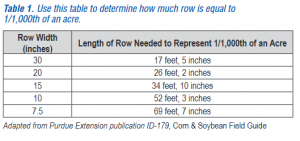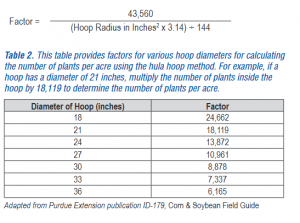Thin Soybean Stands: Should I Replant, Fill In, or Leave Them Alone?
By Andrew P. Robinson, Department of Agronomy, Purdue University and Shawn P. Conley, Department of Agronomy, University of Wisconsin, with additions from Laura Lindsey, Department of Horticulture and Crop Science, The Ohio State University
One of the most difficult early-season management questions that soybean growers ask is “Should I replant this poor soybean stand or leave it alone?” The answer depends on a number of factors, and growers quickly need to make accurate stand and potential yield loss estimates to determine the most profitable course of action.
Identify the Causes of Low Plant Population
The first step all growers should take before making any replant decision is to identify what caused the poor stand. Did the seed fail to germinate, or did it germinate, then die? What caused poor emergence? Identifying the cause is important because if conditions have not changed, then replanting will simply repeat the problem. Early planting is a common source of poor stand problems. Germination can be slow in early-planted fields. Planting in moist, cold soils (below 50ºF) can result in uneven, sporadic, or delayed emergence, giving the false sense of a poor stand (Wuebker et al., 2001). Delayed germination or emergence can make seed more susceptible to disease and other pressures. Seed treated with fungicide will not hasten emergence, but can provide some protection in cool soils for up to three weeks if emergence is delayed. If the plant population seems low in an early-planted field, scout the field by digging up seeds and checking for germination. Look for swollen seeds, plus radicle and hypocotyl growth that would indicate whether a seed is beginning to germinate or is close to emergence.
Determine Stand Density
Growers also need a good estimate of the stand before deciding to replant. There are two common methods for estimating plant populations: counting plants in a row and using the hula hoop method.
No matter which method you use, be sure to count only live plants. Any plant with a stem broken off below the cotyledonary node is considered dead. Plants with missing leaves can recover, but stem damage is more detrimental. Even plants with bruised stems may have difficulty surviving.
Counting Plants in a Row
To determine the stand by counting plants in a row, count the number of plants in a length of row equal to 1/1,000th of an acre (see Table 1).  For row widths not shown in Table 1, use this equation: (43,560 ÷ Row Width measured in feet) divided by 1,000 = Length of Row Equal to 1/1,000th of an Acre. Make at least five counts from different areas of the field, calculate the average, then multiply by 1,000 to get the plant population per acre.
For row widths not shown in Table 1, use this equation: (43,560 ÷ Row Width measured in feet) divided by 1,000 = Length of Row Equal to 1/1,000th of an Acre. Make at least five counts from different areas of the field, calculate the average, then multiply by 1,000 to get the plant population per acre.
Using the Hula Hoop Method
To determine the stand using the hula hoop method, use any perfectly round hoop (hula hoop, wire, barrel hoop, etc.) with a known diameter.  Toss the hoop in at least five randomly selected locations within a field or where the plant stand is low. Count the plants within each hoop, calculate the average, then multiply it by the appropriate factor from Table 2.
Toss the hoop in at least five randomly selected locations within a field or where the plant stand is low. Count the plants within each hoop, calculate the average, then multiply it by the appropriate factor from Table 2.
If your hoop’s diameter is not listed in Table 2, use this equation to calculate your hoop’s factor (remember, the radius is half the distance of the diameter)
According to Dr. Larua Lindsey, Ohio State University Soybean and Small Grains Specialist, “When soybeans are planted in May, a plant population of 100,000 to 120,000 is generally adequate for maximum yield. However, we do not recommend re-planting soybean unless the stand is <50,000 plants/acre. At low plant populations, soybean plants adjust by increasing the number of branches. If the plant population from several areas within the field is <50,000 plants/acre, a re-plant is likely warranted. If the stand is 50,000 to 100,000 plants per acre, there will likely be a slight yield reduction. If the stand is >100,000 plants/acre yield should be maximized.”
References
Corn & Soybean Field Guide. Purdue Extension publication ID-179.
Semmel, T., E.P. Christmas, and G.C. Marini. An evaluation of supplemental planting to increase marginal stands of narrow row soybean using a 30 inch planter. (American Society of Agronomy, Annual meetings, 10-14 Nov. 2002. Indianapolis, IN). Agron Absts 2002.
Wuebker, E. F., R. E. Mullen, and K. Koehler. 2001. Flooding and temperature effects on soybean germination.Crop Sci. 41:1857-1861